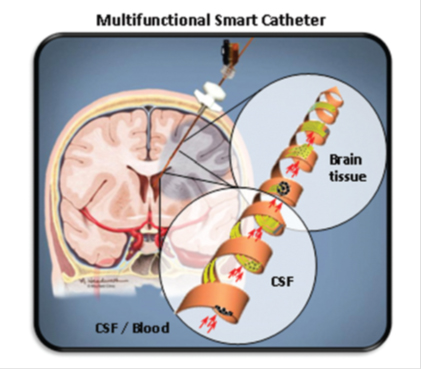Blast events caused by improvised explosive devices (IEDs) remain one of the gravest threats to the Service Member, frequently resulting in severe traumatic brain injury (TBI) which gives rise to a unique pathophysiology and often requires intensive care treatment for weeks following injury. Since primary damage from the initial mechanical injury is irreversible, prevention of secondary injury in the following days to weeks is the focus of TBI treatment. The quality of this treatment is dependent on the ability to effectively and safely monitor the physiology of the brain. The current standard-of-care for severe TBI patients requires monitoring intracranial pressure and possibly brain oxygenation, using multiple devices. Unfortunately, the use of this technology has not kept pace with other advances in medicine, and has remained essentially unchanged for two decades. There is need for a compact but sophisticated neuromonitoring device which can be used in hospitals or during transport and is capable of allowing for targeted interventions before irreversible brain damage occurs.

Collaborators at the Feinstein Institute for Medical Research and the University of Cincinnati received funding from the Psychological Health/Traumatic Brain Injury Research Program managed by the Congressionally Directed Medical Research Program (CDMRP) to develop a single, novel, multimodality neuromonitoring device, or 'smart catheter'. The researchers have taken this catheter through initial design, small scale production, laboratory refinement, and early animal testing. This one-of-a-kind catheter was successfully designed and microfabricated with seven microsensors (intracranial pressure (ICP)), temperature, cerebral blood flow (CBF), oxygen tension, glucose, lactate, and electrocorticography (ECoG)) using a flexible polyimide substrate that is spirally rolled to form a catheter for multimodal sensing of critical intracerebral variables (see figure). The research team tested and validated the function and performance of the complete system in both rat and pig animal models. The collaborating institutions have filed several patent applications covering the technology developed through this project and a patent has been issued for the 'smart catheter' (patent number 8,628,493).
The ability to understand the dynamic and unique pathophysiology of severe neurotrauma using an advanced 'smart catheter' advances the field of neurocritical care. Both the individual sensing technologies as well as the capability to monitor multiple parameters represents tremendous advances in brain monitoring and neuroscience, holding great commercialization potential for biomedical research applications. This ability to safely and effectively monitor the brain will not only improve the understanding of explosive blast neurotrauma but also enhance the care of critically brain-injured Service Members who are being transported across long distances during periods of maximum vulnerability to secondary injury.
Li C, Wu PM, Hartings JA, et al. Smart catheter flow sensor for real-time continuous regional cerebral blood flow monitoring. Applied Physics Letters. 2011; 99: 233705.
Li C, Wu PM, Hartings JA, et al. Micromachined lab-on-a-tube sensors for simultaneous brain temperature and cerebral blood flow measurements. Biomed Microdevices. 2012; 14: 759-68.
Li C, Wu PM, Wu Z, et al. Brain temperature measurement: A study of in vitro accuracy and stability of smart catheter temperature sensors. Biomed Microdevices. 2012; 14: 109-18.
Li C, Wu Z, Hartings JA, et al. Brain-friendly amperometric enzyme biosensor based on encapsulated oxygen generating biomaterial. Conf Proc IEEE Eng Med Biol Soc. 2012; 2012: 6003-6.
Li C, Narayan R.K. Monitoring the injured brain. Bioelectronic Medicine. 2014; 1:4-8.
Li C, Wu P.M, Wu Z, Limnuson K, Mehan N, Mozayan C, Golanov E.V, Ahn C.H, Hartings J.A, Narayan R.K. Highly accurate thermal flow microsensor for continuous and quantitative measurement of cerebral blood flow. Biomedical Microdevices. 2015; 17:87.
Li C, Limnuson K, Wu Z, Amin A, Narayan A, Golanov E.V, Ahn C.H, Hartings, J.A, Narayan R.K. Single probe for real-time simultaneous monitoring of neurochemistry and direct-current electrocorticography. Biosensors and Bioelectronics. 2016; 77: 62-68.
Li C, Wu Z, Limnuson K, et al. Development and application of a microfabricated multimodal neural catheter for neuroscience. Biomed Microdevices. 2016; 18: 8.
Li C, Narayan RK, Wu PM, et al. Evaluation of microelectrode materials for direct-current electrocorticography. Journal of Neural Engineering. 2016; 13: 016008.
Wu Z, Li C, Hartings JA, Narayan RK, Ahn CH. Polysilicon Thin Film Developed on Flexible Polyimide for Biomedical Applications. Journal of Microelectromechanical Systems. 2016; 25(4): 585-592.
Wu Z, Li C, Hartings JA, Narayan RK, Ahn C. Polysilicon based flexible temperature sensor for high spatial resolution brain temperature monitoring. 2016 38th Annual International Conference of the IEEE Engineering in Medicine and Biology Society (EMBC), Orlando, FL, 2016; 6497-6500.
Li C, Narayan RK, Wang P, Hartings JA. Regional temperature and quantitative cerebral blood flow responses to cortical spreading depolarization in the rat. Journal of Cerebral Blood Flow and Metabolism, in press.
Limnuson K, Narayan RK, Bouton C, Wang P, Li C. Development of a brain monitoring system for multimodality investigation in awake rats. 2016 38th Annual International Conference of the IEEE Engineering in Medicine and Biology Society (EMBC), Orlando, FL, 2016; 4487-4490.
Li C, Chaung W, Mozayan C, Charbra R, Wang P, Narayan RK. A new approach for on-demand generation of various oxygen tensions for in vitro hypoxia models. PLoS ONE 2016; 11(5): e0155921.
Limnuson K, Narayan R, Chiluwal A, Golanov E, Bouton C, Li C. A user-configurable headstage for multimodality neuromonitoring in freely moving rats. Frontiers in Neuroscience. 2016; 10:382.
Your 15 minute session will timeout in approximately 10 minutes.
If you're in the middle of entering information, please close this warning and save your progress (if possible) or finish up your task.
If your session fully times out, you will lose any un-saved work.
Your current Blast Injury Research Program session has expired.
Your next click will take you away from the private area, and you will lose any work you have in-progress.
Please enter your email address, and try again.